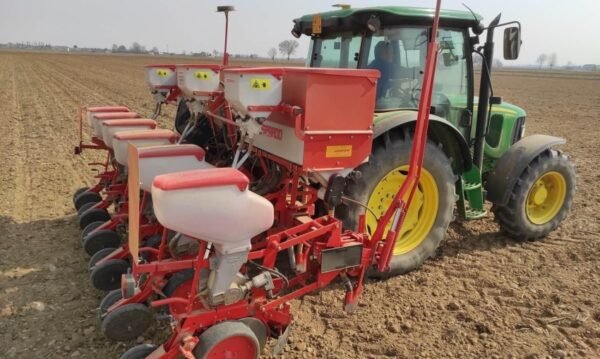For smallholder farmers, owning a tractor is a game-changer. But what truly unlocks a tractor’s full potential is not the machine itself—it’s the attachments you pair with it.
Whether you’re growing maize, vegetables, or managing mixed farming systems, the right implements can save time, cut costs, and help you do more with less labor.
In this guide, we explore the must-know tractor attachments for smallholder farmers, breaking down what they do, why they matter, and how to choose what fits your farm best.
1. Ploughs – The First Step to Good Soil Preparation
Ploughs are among the most basic yet crucial attachments. They break up compacted soil, bury weeds, and prepare land for planting.
Types:
-
Mouldboard Ploughs: Ideal for deep tillage and turning over heavy soils.
-
Disc Ploughs: Better suited for rocky or trashy fields.
Why it matters: Proper ploughing improves soil aeration, water infiltration, and root penetration—critical for healthy crop growth.
Tip for smallholders: Choose a plough that matches your tractor’s horsepower and your soil type. For light tractors, two-bottom ploughs are often sufficient.
2. Harrows – Smoothing and Finishing Your Soil
After ploughing, harrowing is the next step. It breaks down large soil clods, levels the field, and incorporates residues or fertilizers.
Common types:
-
Disc Harrows: Great for rough fields and heavy work.
-
Spring Tine Harrows: Ideal for lighter soils and seedbed preparation.
Benefits: A well-harrowed field reduces seed loss and ensures uniform germination.
SEO Tip: “Best tractor harrow for small farms” is a growing keyword phrase—farmers are actively researching this online.
3. Seed Drills and Planters – Precision in Planting
Hand-seeding may work for very small plots, but it’s inefficient and inconsistent. Tractor-mounted seed drills or planters ensure even seed distribution and correct planting depth.
Advantages:
-
Save time and labor.
-
Increase crop uniformity and yield.
-
Some models can apply fertilizer simultaneously.
Popular with: Maize, wheat, beans, and soybean farmers.
For smallholders: Opt for multi-crop seed drills with adjustable row spacing for more flexibility.
4. Rotary Tillers – One-Pass Wonder
Rotary tillers (also called rotavators) are excellent for secondary tillage. They crush soil clumps, mix organic matter, and prepare a fine seedbed in one pass.
Ideal for: Vegetable farmers or those practicing conservation agriculture.
Why use it: Reduces fuel costs and time spent in the field.
Note: Ensure your tractor has the PTO (Power Take-Off) capacity to run the tiller efficiently.
5. Trailers – Essential for Farm Logistics
A tractor-mounted trailer may seem basic, but it’s one of the most versatile tools for any farm.
Uses include:
-
Transporting harvests, feed, water, tools, or manure.
-
Reducing reliance on external transport.
Advice for smallholders: A tipping trailer adds value for unloading soil, compost, or sand with ease.
6. Boom Sprayers – For Effective Crop Protection
Crop diseases and pests can wipe out months of hard work. Boom sprayers offer a consistent, time-saving way to apply pesticides, herbicides, and foliar feeds.
Features to consider:
-
Tank size (match it to your acreage).
-
Nozzle spacing and spray width.
-
Pump type (diaphragm or piston).
Pro tip: Regular calibration is key to avoiding under- or over-application.
7. Ridgers – Perfect for Row Crops
For crops like potatoes, cassava, and beans, ridgers shape raised beds or furrows that improve drainage and root development.
Benefits:
-
Prevents waterlogging.
-
Eases harvesting.
-
Helps with mechanized planting.
Recommendation: Match the ridger size with your row crop spacing for optimal performance.
8. Post Hole Diggers – Save Time and Energy
Need to install fencing, plant trees, or erect structures? Tractor-mounted post hole diggers make light work of drilling holes.
Why it’s great: Compared to manual digging, you’ll save hours of backbreaking labor, especially in tough soils.
9. Backhoes and Front-End Loaders – For Utility Work
Though not often seen on small farms, front-end loaders and backhoes are becoming more common as farms diversify.
Use cases:
-
Moving compost or manure.
-
Digging irrigation ditches or trenches.
-
Lifting bulky items.
If your tractor supports these attachments, they can serve many off-season or construction purposes.
10. Water Pumps (PTO-Driven) – Vital for Irrigation
Access to water is everything. PTO-driven water pumps allow farmers to draw water from rivers, dams, or boreholes using the tractor’s engine.
Use them for:
-
Irrigating fields.
-
Filling water tanks or livestock troughs.
-
Emergency drought management.
Final Thoughts: Choosing the Right Attachments for Your Farm
While it’s tempting to buy every tool, prioritize attachments that solve your biggest farm challenges first. Consider:
-
Farm size and topography.
-
Crop type and rotation system.
-
Available tractor horsepower.
-
Budget and cost of maintenance.
Also, explore rental options or group ownership through farmer cooperatives to minimize upfront costs.
If you’re new to tractor attachments or unsure where to begin, consult with your local dealer or agricultural extension officer.
Many governments and NGOs also support smallholders with subsidized implements or training on usage and maintenance.
Remember, your tractor is only as useful as the attachments you put behind it.
Also Read
Top 5 Tips for Finding Rare Tractor Parts on Yesterday’s Tractor
